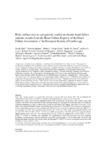Body surface area as a prognostic marker in chronic heart failure patients: results from the Heart Failure Registry of the Heart Failure Association of the European Society of Cardiology

Ver/
Use este enlace para citar
http://hdl.handle.net/2183/22128Coleccións
- INIBIC-ICATC - Artigos [174]
Metadatos
Mostrar o rexistro completo do ítemTítulo
Body surface area as a prognostic marker in chronic heart failure patients: results from the Heart Failure Registry of the Heart Failure Association of the European Society of CardiologyAutor(es)
Data
2016-07-18Cita bibliográfica
Zafrir B, Salman N, Crespo-Leiro MG, et al. Body surface area as a prognostic marker in chronic heart failure patients: results from the Heart Failure Registry of the Heart Failure Association of the European Society of Cardiology. Eur J Heart Fail. 2016; 18(7): 585-868
Resumo
[Abstract] AIMS: The 'obesity paradox' is consistently observed in patients with heart failure (HF). We investigated the relationship of body surface area (BSA) to mortality and hospitalizations in patients with chronic HF.
METHODS AND RESULTS: Data from the outpatient cohort of the observational, prospective, Heart Failure Long-Term Registry of the Heart Failure Association of the European Society of Cardiology was analysed in order to evaluate the prognostic significance of BSA in chronic HF. A total of 9104 chronic HF patients (age 64.8 ± 13.4 years; 71.6% males) were enrolled. Mortality during 1-year follow-up was observed in 718 of 8875 (8.1%) patients. A progressive, inverse relationship between all-cause mortality and BSA levels was observed; the adjusted hazard ratio (HR) for 1-year mortality was 1.823 [95% confidence interval (CI) 1.398-2.376], P < 0.001 for the lowest quartile of BSA <1.78 m(2) , and 1.255, 95% CI 1.000-1.576, P = 0.05 for the middle two quartiles (1.78 ≤BSA ≤2.07 m(2) ), compared with the highest quartile (BSA >2.07 m(2) ). For each increase of 0.1 m(2) in BSA, an adjusted HR of 0.908 (95% CI 0.870-0.948), P < 0.001 for mortality was calculated. HF hospitalizations were not associated with BSA subgroup distribution. In both genders, subjects within the lowest BSA quartile (males <1.84 m(2) and females <1.64 m(2) ) had significantly higher mortality rates during follow-up (log-rank P < 0.0001). However, the stepwise association with mortality was more distinct in males.
CONCLUSIONS: Total and cardiovascular mortality, but not HF hospitalizations was inversely associated with BSA levels in chronic HF patients. BSA may serve as a prognostic indicator for adverse outcome in HF patients.
Palabras chave
Heart failure
Body surface areas
Obesity
Prognosis
Body surface areas
Obesity
Prognosis
Versión do editor
Dereitos
This is the peer reviewed version of the article which has been published in final form at Wiley Online Library. This article may be used for non-commercial purposes in accordance with Wiley Terms and Conditions for self-archiving.
ISSN
1388-9842





